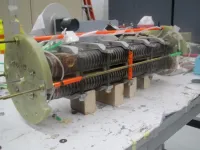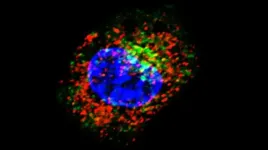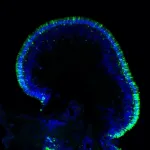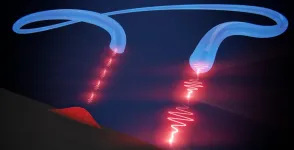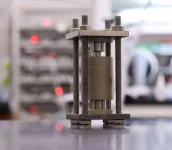(Press-News.org) With a powerful enough light, you can see things that people once thought would be impossible. Large-scale light source facilities generate that powerful light, and scientists use it to create more durable materials, build more efficient batteries and computers, and learn more about the natural world.
When it comes to building these massive facilities, space is money. If you can get higher-energy beams of light out of smaller devices, you can save millions on construction costs. Add to that the chance to significantly improve the capabilities of existing light sources, and you have the motivation behind a project that has brought scientists at three U.S. Department of Energy national laboratories together.
This team has just achieved an important milestone that has been in the works for more than 15 years: They have designed, built and fully tested a new state-of-the-art half-meter-long prototype magnet that meets the requirements for use in existing and future light source facilities.
The next step, according to Efim Gluskin, a distinguished fellow at DOE's Argonne National Laboratory, is to scale this prototype up, build one that is more than a meter long, and install it at the Advanced Photon Source, a DOE Office of Science User Facility at Argonne. But while these magnets will be compatible with light sources like the APS, the real investment here, he said, is in the next generation of facilities that have not yet been built.
"The real scale of this technology is for future free-electron laser facilities," Gluskin said. "If you reduce the size of the device, you reduce the size of the tunnel, and if you can do that you can save tens of millions of dollars. That makes a huge difference."
That long-term goal brought Gluskin and his Argonne colleagues into collaboration with scientists from Lawrence Berkeley National Laboratory and Fermi National Accelerator Laboratory, both DOE labs. Each lab has been pursuing superconducting technology for decades and has in recent years focused research and development efforts on an alloy that combines niobium with tin.
This material remains in a superconducting state -- meaning it offers no resistance to the current running through it -- even as it generates high magnetic fields, which makes it perfect for building what are called undulator magnets. Light sources like the APS generate beams of photons (particles of light) by siphoning off the energy given off by electrons as they circulate inside a storage ring. The undulator magnets are the devices that convert that energy to light, and the higher a magnetic field you can generate with them, the more photons you can create from the same size device.
There are a few superconducting undulator magnets installed at the APS now, but they are made of a niobium-titanium alloy, which for decades has been the standard. According to Soren Prestemon, senior scientist at Berkeley Lab, niobium-titanium superconductors are good for lower magnetic fields -- they stop being superconducting at around 10 teslas. (That's about 8,000 times stronger than your typical refrigerator magnet.)
"Niobium-3 tin is more complicated material," Prestemon said, "but it is capable of transporting current at a higher field. It is superconductive up to 23 tesla, and at lower fields it can carry three times the current as niobium-titanium. These magnets are kept cold at 4.2 Kelvin, which is about minus 450 degrees Fahrenheit, to keep them superconducting."
Prestemon has been at the forefront of Berkeley's niobium-3 tin research program, which began back in the 1980s. The new design, developed at Argonne, built on the previous work of Prestemon and his colleagues.
"This is the first niobium-3 tin undulator that has both met the design current specifications and been fully tested in terms of magnetic field quality for beam transport," he said.
Fermilab started working with this material in the 1990s, according to Sasha Zlobin, who initiated and led the niobium-3 tin magnet program there. Fermilab's niobium-3 tin program has centered on superconducting magnets for particle accelerators, like the Large Hadron Collider at CERN in Switzerland and the upcoming PIP-II linear accelerator, to be built on the Fermilab site.
"We've demonstrated success with our high-field niobium-3 tin magnets," Zlobin said. "We can apply that knowledge to superconducting undulators based on this superconductor."
Part of the process, according to the team, has been learning how to avoid premature quenches in the magnets as they approach the desired level of magnetic field. When the magnets lose their ability to conduct current without resistance, the resulting backlash is called a quench, and it eliminates the magnetic field and can damage the magnet itself.
The team reported in the Proceedings of the Applied Superconductivity Conference 2020 that their new device accommodates nearly twice the amount of current with a higher magnetic field than the niobium-titanium superconducting undulators currently in place at the APS.
The project drew on Argonne's experience building and operating superconducting undulators and Berkeley and Fermilab's knowledge of niobium-3 tin. Fermilab helped to guide the process, advising on the selection of superconducting wire and sharing recent developments in their technology. Berkeley designed a state-of-the-art system that uses advanced computing techniques to detect quenches and protect the magnet.
At Argonne, the prototype was designed, fabricated, assembled and tested by a group of engineers and technicians under the guidance of Project Manager Ibrahim Kesgin, with contributions in the design, construction and testing by members of the APS superconducting undulator team led by Yury Ivanyushenkov.
The research team plans to install their full-sized prototype, which should be finished next year, at Sector 1 of the APS, which makes use of higher-energy photon beams to peer through thicker samples of material. This will be a proving ground for the device, showing that it can operate at design specifications in a working light source. But the eye, Gluskin says, is on transferring both technologies, niobium titanium and niobium-3 tin, to industrial partners and manufacturing these devices for future high-energy light source facilities.
"The key has been steady and persistent work, supported by the labs and DOE research and development funds," Gluskin said. "It has been incremental progress, step by step, to get to this point."
INFORMATION:
Fermilab is supported by the Office of Science of the U.S. Department of Energy. The Office of Science is the single largest supporter of basic research in the physical sciences in the United States and is working to address some of the most pressing challenges of our time. For more information, please visit energy.gov/science.
Attempts to identify the genetic causes of neuropsychiatric diseases such as post-traumatic stress disorder (PTSD) through large-scale genome-wide analyses have yielded thousands of potential links. The challenge is further complicated by the wide range of symptoms exhibited by those who have PTSD. For instance, does extreme arousal, anger, or irritation experienced by some have the same genetic basis as the tendency to re-experience traumatic events, another symptom of the disorder?
A new study led by researchers at Yale and the University of California-San Diego (UCSD) provides answers to some of these questions and uncovers intriguing genetic similarities between PTSD and other mental health disorders such as anxiety, bipolar disorder, and schizophrenia. ...
Washington, DC - January 28, 2021 - Self swabs and caregiver swabs are effective at detecting multiple pathogens and are just as accurate as those taken by healthcare workers, according to a team of Australian researchers. The research appears in the Journal of Clinical Microbiology, a publication of the American Society for Microbiology.
"Across the range of pathogens and swab types, there was high agreement between results from self- or caregiver swabs and those performed by a healthcare worker, even when different sites were swabbed (e.g. nasopharyngeal vs. nasal)," said principal investigator Joshua Osowicki, BMedSci, MBBS, FRACP, a Pediatric Infectious Diseases physician in the Murdoch Children's Research Institute's ...
Despite long-standing ideas about the importance of thumb evolution in tool use and development, questions remain about exactly when human-like manual dexterity and efficient thumb use arose--and which hominin species was the first to have this ability. Now, researchers who've analyzed the biomechanics and efficiency of the thumb across different fossil human species using virtual muscle modeling have new insight into when these abilities first arose and what they've meant for the development of more complex human culture. The findings, appearing January 28 in the journal Current Biology, suggest that a fundamental aspect of human thumb opposition first appeared approximately 2 million years ago and was not found ...
What makes one person drive above the speed limit while another navigates steadily in the right lane? What motivates someone to leave a job with a steady paycheck to launch their own business while the other sticks to one employer for an entire career?
"People have different tendencies to engage in behavior that risks their health or that involve uncertainties about the future," says Gideon Nave, an assistant professor of marketing in Penn's Wharton School.
Yet explaining the origin of those tendencies, both in the genome and in the brain, has been challenging for researchers, partly because previous studies on ...
ANN ARBOR, Michigan -- It was an unexpected discovery that started with an analysis of more than 1,000 genes. The question: why game-changing cancer immunotherapy treatments work for only a fraction of patients.
The analysis shone a light on one that popped up repeatedly in patients and mouse models that did not respond to immune checkpoint therapy: stanniocalcin-1, a glycoprotein whose role in both tumors and immunology is largely unknown.
By following the trail from this surprising thread, a University of Michigan Rogel Cancer team uncovered how stanniocalcin-1, or STC1, works inside the cell to block a cellular "eat-me" signal that typically triggers the immune system to produce T cells to fight the tumor. The findings, published in ...
Scientists at the National Eye Institute (NEI) have developed a promising gene therapy strategy for a rare disease that causes severe vision loss in childhood. A form of Leber congenital amaurosis, the disease is caused by autosomal-dominant mutations in the CRX gene, which are challenging to treat with gene therapy. The scientists tested their approach using lab-made retinal tissues built from patient cells, called retinal organoids. This approach, which involved adding copies of the normal gene under its native control mechanism, partially restored CRX function. The study report appears today in Stem ...
In early October 2019, when an unknown caller rang EPFL professor Johan Gaume's cell phone, he could hardly have imagined that he was about to confront one of the greatest mysteries in Soviet history. At the other end of the line, a journalist from The New York Times asked for his expert insight into a tragedy that had occurred 60 years earlier in Russia's northern Ural Mountains - one that has since come to be known as the Dyatlov Pass Incident. Gaume, head of EPFL's Snow and Avalanche Simulation Laboratory (SLAB) and visiting fellow at the WSL Institute for Snow and Avalanche Research SLF, had never heard ...
Researchers at the University of Basel and Ruhr University Bochum have developed a source of single photons that can produce billions of these quantum particles per second. With its record-breaking efficiency, the photon source represents a new and powerful building-block for quantum technologies.
Quantum cryptography promises absolutely secure communications. A key component here are strings of single photons. Information can be stored in the quantum states of these light particles and transmitted over long distances. In the future, remote quantum processors will communicate with each other via single photons. And perhaps the processor itself will use photons as quantum bits for computing.
A basic prerequisite for such applications, however, is an efficient source ...
Using X-ray tomography, a research team has observed the internal evolution of the materials inside solid-state lithium batteries as they were charged and discharged. Detailed three-dimensional information from the research could help improve the reliability and performance of the batteries, which use solid materials to replace the flammable liquid electrolytes in existing lithium-ion batteries.
The operando synchrotron X-ray computed microtomography imaging revealed how the dynamic changes of electrode materials at lithium/solid-electrolyte interfaces determine the behavior of solid-state batteries. The researchers found that battery operation caused voids to form ...
Science is society's best method for understanding the world, yet many people in the field are unhappy with the way it works. Rules and procedures meant to promote innovative research can have perverse side-effects that harm both science and scientists. One of these - the 'priority rule' - rewards scientists who make discoveries with prestige, prizes and better career opportunities, depriving the runners-up of similar perks. Researchers at University of Technology Eindhoven (TU/e) and the Arizona State University in the US have developed a new model to better understand this rule, and see if current reforms to improve the system actually make sense. Their study was published in Nature Human Behaviour.
"Over the past decade, there have been growing concerns that something ...
